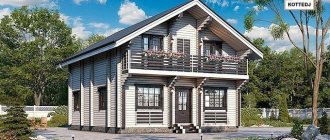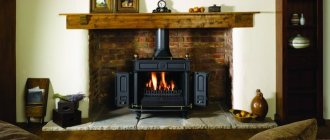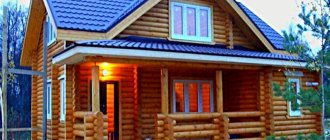Historical reference
The presence of a Russian stove has become a real legend - previously such heating structures were installed in every private house. They have become an integral part of Russian folklore. Even today it is difficult to find a replacement for a Russian stove, taking into account its reliability!
It is not known exactly when they began installing similar structures for heating homes in Russia. According to approximate data, their prototypes appeared 4 thousand years ago, when people decided to equip their house with the ability to make a fire hidden under clay materials.
Stove in a rural wooden house
In Rus', stoves were distinguished by the peculiarity of their masonry. Until the 13th century, the most common variants were chimneys, in which there were no chimney pipes facing the street. In such options, smoke escaped from the premises due to drafts through the door, but at the same time, soot constantly settled on any surfaces, which caused a lot of inconvenience.
However, the usual version appeared only in the 18th century. Then they were made of bricks with fire-resistant properties, they had chimneys. At that time, such structures were placed exclusively in the corners of huts, not far from the front door. It was permissible to leave a small space between the wall and the stove, where various kitchen utensils were stored.
Russian stoves and modern interiors
A large number of folk beliefs are associated with the Russian stove, but then the 20th century came - all this became a thing of the past. The development of technological progress has made its own adjustments to the installation of autonomous heating in any private homes. People most often began to equip city houses with gas or electric heating. However, the classic type Russian stove is economical and easy to use, which is why today the fashion for installing it is returning in country houses.
Small stove in the living room decorated with tiles
Modern options are no longer used for direct cooking, since it is important to use electric and gas burners. However, this is still an effective way to organize autonomous heating of a house, as well as a decorative element of a modern interior, and quite an original one at that.
Masonry of a Russian stove
Before work, it is important to study the designs of Russian stoves. There are different options, so the masonry scheme may differ
The drawings cannot be changed - the specified order must be strictly followed.
Complete tightness is important for the safety of the structure. This is ensured by the following points:
- Use quality stone. There shouldn't be any cracks.
- The seams between the rows are 0.5-0.8 cm thick.
- Do not coat the inner walls with clay - soot will be deposited on them, and therefore thermal conductivity will decrease.
- Different departments differ in the thickness of the masonry from ¼ of the thickness of the brick to its full length.
- If the brick is ceramic, then it needs to be soaked to prevent moisture from being absorbed from the mortar.
Don't miss: How to properly make a stationary oven, barbecue and barbecue out of brick at your dacha with your own hands: step-by-step instructions, advantages and disadvantages
Varieties of options
During the existence of the Russian stove, quite a lot of variants of its design appeared, which differ from each other in some design features. The first most obvious design element that immediately catches your eye is the type of bed - they come in different sizes or shapes:
- with transverse beds located behind the mouth with a pipe. This is a typical option, which provides two beds at once;
- with a longitudinal type of bed, when it is located behind the firebox. This makes the bed wider, and also provides additional storage space for various equipment.
Obvious differences may be different options for the inflow device:
- the classic inflow is located on one side;
- a firebox with a fireplace allows you to combine a stove with a fireplace, while the fireplace can be brought into another room.
Selection of a Russian stove today
It is worth considering various options for constructing a Russian stove in order to choose the most suitable device. They differ in size and functionality, so it’s worth taking a closer look at each option.
"Alya-rus"
The “ala-rus” option was created, rather, for design purposes, since it collects many classic household items and decorations that are usually associated with Russia and the history of the Russian village. However, there are a number of features:
- do not overload the structure with decorative elements or designs;
- for decoration you can use a balalaika or bunches of dried berries and herbs;
- There will definitely be a place on the walls for embroidered towels or amulets.
Such a stove will be a bright, noticeable spot that will never go unnoticed. For those who are close to traditional Russian superstitions, handmade figurines of brownies would be an excellent decoration option.
Russian hut
In a Russian hut, the classic interior is usually decorated from wooden materials. A classic stove made of brick or clay, finished with decorative materials, fits perfectly into the room. It has a number of features:
- You can use tiles for decoration, but it is unacceptable to use excessively bright shades;
- It is preferable to use blue, white and blue tones of decoration, inclusions of golden shades are acceptable;
- Old Russian classic patterns are used for decoration, which harmonize perfectly with wooden finishing materials.
This design does not necessarily have to be functional. It can only be used as a decorative element, decorating the room, giving it a cozy appearance.
Russian tower
The rich decoration of the Russian tower is most reminiscent of typical illustrations for old Russian fairy tales. A stove made in this style is a very bright and unusual spot in a modern interior, and it will go well with both classic wood and any modern materials. This type of oven has some characteristic features:
- it is permissible to decorate with a large number of tiles, giving a fabulous look to the design;
- the dimensions in this case are usually quite impressive, so it is worth choosing this option for large areas and rooms with massive large windows;
- When decorating, bright and unusual shades are used, and colorful tiles do not interfere with design ideas at all in this case.
If this option is not planned to use the heating function, then it is possible to make a decorative semblance of a stove against the wall from wooden materials, and the design can be complemented by an electric fireplace. In this case, the stove becomes exclusively a decoration, giving the interior motifs of a rustic Russian style.
Classification of Russian stoves
It is quite rare to find two absolutely identical stoves, since each master has his own proven method of laying. However, the internal structure of the stove remains virtually unchanged. Today they can be classified according to the main criteria:
- size;
- additions to the design.
Furnace dimensions
The fundamental criterion for classifying furnaces is their size:
- Large (from 150*230 cm or more) - such a Russian stove is capable of heating several fairly large adjacent rooms;
- Medium (up to 150*175 cm) - this type of stove heats a room up to 40 square meters in size;
- Small (up to 150*170 cm) - this version of the stove can heat only a small room, can only be used as an interior decorative element or serve as an additional source of heat.
Additional oven functions
Since the construction of the first stove, Russian stoves have combined many functions. The functionality of modern furnaces is calculated in accordance with the options for their future operation and customer requirements:
- for housewives who want to cook in a Dutch oven, options are made with an oven and an additional stove (made of cast iron);
- for those who like to spend time in front of the fire, stoves are placed that combine a fireplace and a traditional stove, united by a single chimney, thus combining convenience and benefit;
- if the customer is interested in a pleasant rest in the warmth, then an option is made with a trestle bed, equipped with a separate firebox, independent of the main stove.
Where to install
In country houses, modern homeowners are increasingly returning the Russian stove to their interiors, since neither kitchen appliances nor various heaters can actually replace the live fire and heat from a real stove. But when the question arises about the location of the stove, there are a lot of nuances that should be taken into account when planning the installation of a Russian stove.
Installation in the living room
In this option, the stove becomes the central element of the interior of the room. That is why very bright and beautiful stove design options are most often chosen for the living room, and the stove itself is installed at a fairly large distance from the furniture elements of the room.
Living rooms made in a rustic style are very popular today, which are quite inexpensive and at the same time look very impressive. To create such interiors, mostly wooden and metal materials are used, and the furniture does not have any frills or overly elaborate details.
It is worth remembering some nuances:
- furniture is selected with pastel colors in the design, as well as without unnecessary decorative elements, so that they do not distract attention from the main element - the Russian stove;
- lighting must be selected unobtrusively, using discreet lamps or stylized kerosene lamps;
- On top of the stove you can equip a bed with handmade blankets and soft pillows embroidered with Russian patterns.
For modern furniture and interiors decorated without wooden materials, stoves with a strict design, without unnecessary decorative elements, in a minimalist style are perfect. It is acceptable to finish the stove with artificial decorative stone or finishing brick, and expensive furniture options, including upholstered furniture with leather upholstery, are in perfect harmony with such options.
Installation in the kitchen
The kitchen is a classic place to install a Russian stove. It must be said that this is the best place, but there are some nuances here, since modern cuisine is significantly different from the ancient Russian cuisine of classic wooden houses. When installing, keep the following points in mind:
- It is unacceptable to install household appliances near the stove - they should all be at a fairly impressive distance;
- the dining part of the room should not be in close proximity to the stove so that it does not get too hot;
- You should not overload the outer sides of the Russian stove with decorations and various small decorative elements.
For a rustic kitchen, a minimalist style using wooden materials will be relevant. It is better to leave suspended ceilings and wallpaper for city apartments - their surfaces quickly become unusable due to high temperatures, and it is better to leave wooden finishing materials or paints and varnishes.
It is important for the kitchen to remain bright and cozy, so large windows are made in the room, and appropriate lighting fixtures are installed. The bright design of the Russian stove in the kitchen using noticeable stains and paints for a design accent will be relevant.
Country house kitchen interior
The second most important room in a village house is the kitchen. We maintain the style of the interior without giving up the benefits of civilization.
The style largely replicates the interior of the living room of a country house: wooden floors or solid parquet floors, whitewashed or painted ceiling. If the size of the kitchen allows, do not refuse false beams on the ceiling. False beams must be dark in color and stand out in contrast against the white ceiling.
The decoration of the walls depends on their material. Wooden walls can also be faced with a block house or imitation timber. It is advisable to cover brick walls with tiles to resemble aged brick. The choice of color scheme will be determined by the color of the furniture - you should not choose a tile color that is too rich for light-colored kitchen furniture. At least some of the furniture should be wooden. Or have wooden facades. The facades can be decorated with carvings. Modern kitchen appliances can also be hidden behind wooden facades, but this is a matter of taste.
Everything else is at your discretion. Clay pots, decorative plates, embroidered towels, and bunches of onions and garlic will look beautiful in a rustic kitchen.
Throw a rag rug on the floor. These are crocheted in villages. And hang white lace curtains on the windows.
Lighting can be arranged with lamps in the form of bright yellow flowers.
A great idea would be to install wooden benches covered with crocheted throws around the table.
And don’t forget to place a pot-bellied samovar on the table!
Decorating other rooms in the house in a rustic style is up to you. You can limit yourself to just the kitchen and living room; you can decorate all rooms in this style. The main thing is that your home is cozy, comfortable and warm. You are quite capable of decorating your interior in a rustic style. Moreover, by doing this finishing, you will get involved in the process, learn a lot of interesting things and will be able to competently discuss with any specialist in the field of rustic style in the interior.
- Author: Maria Sukhorukikh
Rate this article:
- 5
- 4
- 3
- 2
- 1
(0 votes, average: 0 out of 5)
Share with your friends!
Furnace decoration
Today, different materials are used to decorate a Russian stove. They are selected depending on whether the stove is new or an old stove needs repair, as well as how the room looks. In the case of an old stove, work is first carried out to prepare the surfaces, including eliminating cracks and removing old plaster, as well as dismantling old structures in order to replace them with new ones.
Once all surfaces are in working order, they can be decorated using a variety of modern or classic materials, as well as various design styles depending on the overall style in which the house is decorated.
Tiles
Traditional decorations for Russian stoves are tiles. They give the product a colorful and incredibly beautiful appearance, and are also reliable and of high quality, and are made from refractory types of clay. They are attached to the oven wall using a gun, and their front part is covered with glaze and ornamentation to achieve maximum decorative effect.
Among the features of such decorative materials are:
- tiles are permissible only when decorating options with brickwork;
- the cladding is laid from bottom to top, constantly wetting the tiles with water;
- For grouting joints, gypsum dough with a special composition is used.
There are a huge number of tile patterns, and for their implementation, both relief and flat tiles with different color designs are used. Tiles can be plain or painted, and can also be made in several colors. The colors of the tiles should be selected taking into account the general style of the premises of the private house where the Russian stove is installed.
Plaster and paint
A budget option for facing materials would be decorative plaster or modern types of decorative paint. This is the cheapest option, but no less beautiful. A relevant option for modern interiors in a minimalist style that do not have unnecessary decorative elements.
Among the features of this finish we can highlight:
- the need to heat the stove and wet the walls with water before starting work;
- the plaster is applied in at least two layers, and the second should be thicker;
- After plastering, a layer of paint or decorative plaster is applied.
In this case, any color of the materials for cladding is possible, and should be selected exclusively in accordance with the design style of the premises of a private house. If you need to visually reduce the size of the structure a little, then you should choose darker paint options for the corresponding effect, so that the stove is darker than other furnishings in the rooms.
Decorative tiles
The tile is a very original and beautiful design option. Such finishing materials can be secured with adhesive mortar and nails to hold the edges of the tiles. Among very unusual materials, you can select natural stone, such as marble or granite, but this is quite expensive.
Features of tiled decoration are:
- the need to select heat-resistant tiles that will not burst due to temperature;
- the importance of choosing a high-quality, durable solution for fixing materials.
Visually, such materials have a cold effect, and therefore are more suitable for wide living rooms or kitchens. For small living rooms, it is better to choose other finishing options in order to achieve a warmer visual effect for the Russian stove.
Household decoration
Replacing the cladding is a rather costly and serious issue that will require a lot of effort and money. However, if the stove is old and the flaws are not too noticeable, then you can get by with decorating it with various household elements. Disadvantages can be hidden using a variety of things:
- towels embroidered with traditional patterns;
- old style pottery and cast iron pots;
- bunches of dried berries or herbal mixtures;
- wood stands and woodpile near the stove;
- pillows, skins and blankets on the bed.
In addition, you can place various shelves for pots, dishes and other kitchen utensils, which will not only decorate the walls, but also make them functional.
Materials for the Russian stove
The design of a country house stove will largely depend on the material used. The traditional design was “sculpted” from clay. More modern models were created from brick. Stoves made of cast iron and steel also played an important role.
These are the so-called potbelly stoves. For many, they are associated with something unsightly and rude, but the modern range of mobile and compact heating devices allows you to choose quite sophisticated options.
Brick
Beautiful brick stoves for the home are the dream of true romantics and fans of Slavic flavor. A special advantage of the structures is the “breathable” material. A brick fireplace is a specific microporous body. It releases moisture vapor into the air, and when it cools, it takes it back. A stone heating unit is not capable of this.
A well-designed stove is useful for both heating and cooking. Many models of brick Russian stoves also work as a barbecue or grill.
Clay
A simple log house of poor people was always complemented by a clay stove. In the modern format, only finishing is made from this material and the sunbed is lubricated. Such a fireplace stove will look luxurious in the interior of a wooden house in a rustic style.
If the heating product is made exclusively on clay, then it will need to be constantly restored. It is necessary to grease and plaster at least once a year.
Cast iron
A wood-burning fireplace made of cast iron has amazing heating properties. The traditional potbelly stove appeared in the 19th century. Initially, such stoves were actively used by the Danes and Germans, and then by the Slavs.
A cast iron fireplace is like a fire: it warms you to the bone if you are in close proximity to it. If you move a decent distance away, the heat will be very soft and delicate. It does not dry out the air.
It is worth noting the disadvantages. Even a relatively small stove with cast iron elements will be very heavy. Huge structures are so heavy that they require strengthening the foundation (in some cases). In addition, cast iron is quite expensive when it comes to expensive materials.
A simple potbelly stove in the interior of a miniature wooden house will always look very stylish. A small unit with ornate “old-fashioned” decor and wooden log walls, a cozy blanket with embroidery and original patterns, indoor flowers - all this will give a person a feeling of calm, relaxation and privacy.
Steel
By analogy with classic cast-iron structures, steel stoves began to be produced. In large units, some elements (for example, the firebox) are replaced with steel ones.
Almost always, the fireboxes of steel furnaces can be lined - they are laid out with fireclay bricks. This is necessary to give the fabric greater heat resistance. You can additionally install tiles on the steel body. It is very fashionable to decorate fireboxes with natural or artificial stone.
Steel structures are much lighter than cast iron prototypes. They are much cheaper, much more mobile in terms of movement (if we are talking about devices like potbelly stoves).
Features of the Russian stove
When installing a Russian stove, you will first need to make sure that the foundation of the building can withstand the extra hundreds of kilograms. Strong foundations are suitable, for the creation of which brick or concrete is chosen. With a pile foundation, additional strengthening is required, and in this case it is better to abandon either the idea of installing a Russian stove or this type of foundation.
At the bottom of the structure there is a base with an equipped chamber, which is usually used to store various additional functional elements, as well as fuel for lighting a Russian stove. The base allows you to raise the stove for more comfortable operation.
A vault is installed on top of the base, on which additional sand or clay is poured, and the bottom of the firebox is installed on it. At the same time, they specially make a slight slope towards the wall, so that it is convenient to use the firebox of a Russian stove and work with fuel. In addition, this is how the fuel will burn evenly.
The firebox consists of a cooking chamber and a crucible, and in front there is an opening with metal flaps for storing fuel, as well as installing utensils with prepared dishes. If you do not plan to use this stove for cooking, then you should abandon this design element.
Furnace finishing
The firebox is finished with the same materials as the stove itself. The main condition when choosing materials is safety, fire resistance, reliability, and strength. When designing the firebox, special attention should be paid to fire safety rules, because this part is most directly related to fire.
It is very important to leave a gap between the firebox and the stove lining. This is necessary for free air circulation, which affects the efficiency of its operation as a whole. It is not advisable to fill this gap with sand or thermal insulation material. It will become a reliable obstacle to deformation of the facing material. If there is a gap, then the finishing material will not crack, voids or other negative aspects will not appear in it.
When using plasterboard structures, leaving a gap will be an additional means against fire. 10 centimeters is the minimum gap that must be left between the firebox and the stove for safety reasons.










